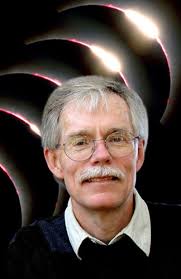Total Eclipse of 2017 Featured in April 11 Physics Neff Lecture and Photography Workshop
 A total eclipse of the sun, visible from northeast Kansas, will occur on August 21, 2017. This is the first total solar eclipse visible from the contiguous United States since 1979. The Physics Department has invited retired NASA astrophysicist Fred Espenak to deliver a Neff Public Lecture in Physics on this striking, celestial event.
A total eclipse of the sun, visible from northeast Kansas, will occur on August 21, 2017. This is the first total solar eclipse visible from the contiguous United States since 1979. The Physics Department has invited retired NASA astrophysicist Fred Espenak to deliver a Neff Public Lecture in Physics on this striking, celestial event.
“The Great American Total Eclipse of 2017,” a general public lecture, will be held Tuesday, April 11, at 4:30 p.m. in Room 101 of Cardwell Hall at Kansas State University. The Neff Lecture will be at a non-technical level and all are invited to attend. Those who are unable to attend will find a livestream of the program as well as an archived version at www.phys.ksu.edu/alumni/neff/2017.
Espenak will discuss the solar eclipse phenomenon, where the Moon covers the disk of the Sun. For the total eclipse of 2017, the track of the Moon’s shadow will cut diagonally across the nation from Oregon to northeast Kansas to South Carolina. Inside this 68-mile wide path of totality, the Moon will completely cover the Sun as the landscape is plunged into an eerie twilight, and the Sun’s glorious corona is revealed for over two minutes.
Espenak will also host an astrophotography workshop in Cardwell 101 at 3:00 pm, prior to the lecture. He will offer advice for amateur and professional photographers on how to use cameras, including cellphone cameras, to shoot wide-angle photos of totality; how to capture partial phases, the diamond-ring effect, and Baily's beads; and how to shoot bracketed exposures to capture the inner, middle and outer corona. He will offer tips on the best telephoto lenses, telescopes and solar filters. Participants should bring their cameras, lenses and questions.
Espenak is known as "Mr. Eclipse" because of his work on predicting and observing solar and lunar eclipses. He has written over a dozen books on eclipses including his most recent "Eclipse Bulletin: Total Solar Eclipse of 2017 August 21."
Espenak also runs three websites - one on eclipse prediction (www.EclipseWise.com), one on eclipse photography (www.MrEclipse.com) and another on astrophotography (www.AstroPixels.com).
Over the past 45 years he has witnessed 26 total eclipses of the Sun.
In 2003, the International Astronomical Union honored Espenak by naming asteroid 14120 after him. Espenak now lives in Portal, Arizona where he operates Bifrost Astronomical Observatory.
Light refreshments will be served prior to the lecture at 4:00 p.m. in Room 119 of Cardwell Hall.
More information about the 2017 Total Eclipse can be found at www.phys.ksu.edu/eclipse-2017/.
This lecture series is supported by an endowment from Dr. James R. Neff in honor of his parents – Everett & Florine Neff.